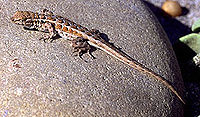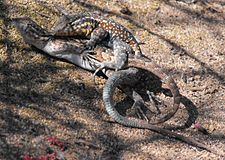- Common side-blotched lizard
-
common side-blotched lizard 
Scientific classification Kingdom: Animalia Phylum: Chordata Subphylum: Vertebrata Class: Reptilia Order: Squamata Suborder: Lacertilia Infraorder: Iguania Family: Phrynosomatidae Genus: Uta Species: U. stansburiana Binomial name Uta stansburiana
Baird & Girard, 1852Subspecies - U. s. stansburiana
northern side-blotched lizard - U. s. nevadensis
Nevada side-blotched lizard - U. s. uniformis
plateau side-blotched lizard - U. s. elegans
western side-blotched lizard - U. s. stellata
San Benito side-blotched lizard - U. s. concinna
Cedros side-blotched lizard - U. s. martinensis
San Martin side-blotched lizard (disputed) - U. s. taylori
Taylor's side-blotched lizard (disputed)
Synonyms Uta concinna
Uta elegans
Uta graciosa
Uta levis
Uta martinensis
Uta mearnsi
Uta microscutata
Uta stansburiana hesperis
Uta stellata
Uta thalassina
Uta wrightiThe common side-blotched lizard (Uta stansburiana) is a species of side-blotched lizard common on the Pacific coast of North America, from Washington to western Texas and NW Mexico. It has a peculiar evolutionary strategy following the pattern of the game of Rock, Paper, Scissors, with three types of males existing, each of which applies a different technique to acquire mates (Sinervo & Lively, 1996; Sinervo, 2001; Alonzo & Sinervo, 2001; Sinervo & Clobert, 2001; Sinervo & Zamudio, 2001).
The specific epithet, stansburiana, is in honor of Captain Howard Stansbury of the United States Corps of Topographical Engineers, who collected the first specimens while leading the 1849-1851 expedition to explore and survey the Great Salt Lake of Utah.[1]
Contents
Systematics
The systematics and taxonomy of these widespread and variable lizards is much disputed (Grismer, 1994; Upton & Murphy, 1997). Countless forms and morphs have been described as subspecies or even distinct species (e.g. Schmidt, 1921).
- The forms which occur in most of Mexico (except Baja California) have been recognized as a very distinct species, the Eastern side-blotched lizard (Uta stejnegeri) (Collins, 1991).
- Populations from San Benito and Cedros Islands were separated as distinct species Uta stellata and U. concinna but are nowadays included in U. stansburiana.
- Those of Santa Catalina Island and the Salsipuedes Islands, U. squamata and U. antiqua are sometimes included in this species too, but this is certainly not correct in the latter case, and probably in the former also.
- Based on the same data that would give U. squamata species rank, the southern Baja California populations could arguably be split off (as Uta elegans) too.
- The proposed subspecies martinensis and taylori are probably not valid.
- The populations on Ángel de la Guarda, Mejia and Rasa Islands almost certainly constitute a separate species closer to Uta palmeri, and that of San Esteban Island may so too, being close to squamata.
- The status of the Las Encantadas group populations named as Uta encantadae, U. lowei and U. tumidarostra is not completely resolved; these distinct populations are of comparatively recent origin and are sometimes included in this species (Murphy & Aguirre-León, 2002), but their unique adaptations to living in intertidal habitat suggest that they should be considered distinct; whether as one or as three species remains unresolved.
Mating strategy
Biologist Barry Sinervo from the University of California, Santa Cruz has discovered a rock-paper-scissors strategy in the mating behaviour of the side-blotched lizard species Uta stansburiana. Males have either orange, blue or yellow throats and each type follows a fixed, heritable mating strategy:[2]
- Orange-throated males are strongest and do not form strong pair bonds; instead, they fight blue-throated males for their females. Yellow-throated males, however, manage to snatch females away from them for mating. The large size and aggression is caused by high testosterone production.
- Blue-throated males are middle-sized and form strong pair bonds. While they are outcompeted by orange-throated males, they can defend against yellow-throated ones. Because blue-throated males produce less testosterone they are not as large as the orange-throated males, but it gives them the advantage of being less aggressive and able to form strong pair bonds.
- Yellow-throated males are smallest, and their coloration mimics females. This lets them approach females near orange-throated males and mate when the males are distracted. This is less likely to work with a female that has bonded with a blue-throated male.
This can be summarized as "orange beats blue, blue beats yellow, and yellow beats orange", which is similar to the rules of rock-paper-scissors.
The proportion of each male type in a population is similar in the long run, but fluctuates widely in the short term. For periods of 4–5 years, one strategy predominates, after which it declines in frequency as the strategy that manages to exploit its weakness increases. This corresponds to the stable pattern of the game in the replicator dynamics where the dynamical system follows closed orbits around the mixed strategy Nash equilibrium[citation needed] (Sinervo & Lively, 1996; Sinervo, 2001; Alonzo & Sinervo, 2001; Sinervo & Clobert, 2003; Sinervo & Zamudio, 2001).
References
- ^ Moll, Edward. 2005. Uta stansburiana, Baird and Girard, 1852 - Common Side-blotched Lizard. Sonoran Herpetologist.
- ^ Sinervo, Barry (2001-02-20). "The rock-paper-scissors game and the evolution of alternative male strategies". http://bio.research.ucsc.edu/~barrylab/lizardland/male_lizards.overview.html. Retrieved 2006-08-20.
- Alonzo, Suzanne H. & Sinervo, Barry (2001): Mate choice games, context-dependent good genes, and genetic cycles in the side-blotched lizard, Uta stansburiana. Behavioral Ecology Sociobiology 49(2-3): 176–186. doi:10.1007/s002650000265 (HTML abstract)
- Collins, Joseph T. (1991): Viewpoint: a new taxonomic arrangement for some North American amphibians and reptiles. Herpetological Review 22(2): 42-43. PDF fulltext
- Grismer, L. L. (1994): Three new species of intertidal side-blotched lizards (Genus Uta) from the Gulf of California, Mexico. Herpetologica 50: 451–474.
- Murphy, Robert W. & Aguirre-León, Gustavo (2002): The Nonavian Reptiles: Origins and Evolution. In: Case, Ted & Cody, Martin (eds.): A New Island Biogeography of the Sea of Cortés: 181-220. Oxford University Press. ISBN 0-19-513346-3 PDF fulltext Appendices 2-4
- Schmidt, Karl Patterson (1921): New species of North American lizards of the genera Holbrookia and Uta. American Museum Novitates 22: 1-6. PDF fulltext
- Sinervo, Barry (2001): Runaway social games, genetic cycles driven by alternative male and female strategies, and the origin of morphs. Genetica 112-113(1): 417-434. doi:10.1023/A:1013360426789 (HTML abstract)
- Sinervo, Barry & Clobert, Jean (2003): Morphs, Dispersal Behavior, Genetic Similarity, and the Evolution of Cooperation. Science 300(5627): 1949-1951. doi:10.1126/science.1083109 (HTML abstract) Supporting Online Material
- Sinervo, Barry & Lively, C. M. (1996): The Rock-Paper-Scissors Game and the evolution of alternative male strategies. Nature 380: 240-243. doi:10.1038/380240a0 (HTML abstract)
- Sinervo, Barry & Zamudio, K. R. (2001): The Evolution of Alternative Reproductive Strategies: Fitness Differential, Heritability, and Genetic Correlation Between the Sexes. Journal of Heredity 92(2): 198-205. PDF fulltext
- Upton, Darlene E. & Murphy, Robert W. (1997): Phylogeny of the side-blotched lizards (Phrynosomatidae: Uta) based on mtDNA sequences: support for midpeninsular seaway in Baja California. Molecular Phylogenetics and Evolution 8(1): 104-113. doi:10.1006/mpev.1996.0392 PDF fulltext
External links
- http://www.qwantz.com/index.php?comic=1827
- UC Santa Cruz: Cooperation between unrelated male lizards adds a new wrinkle to evolutionary theory (Essay on Sinervo & Clobert 2001 paper)
 Media related to Uta stansburiana at Wikimedia CommonsCategories:
Media related to Uta stansburiana at Wikimedia CommonsCategories:- Reptiles of the United States
- Animals described in 1852
- U. s. stansburiana
Wikimedia Foundation. 2010.


